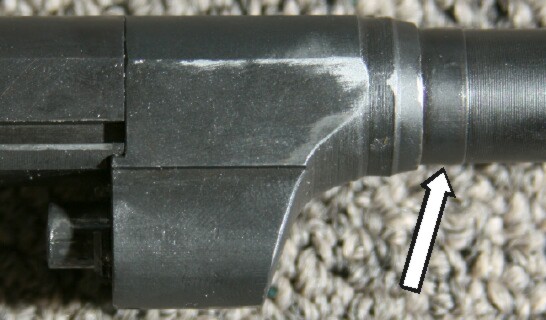 |
U.S. M1 Carbine |
 |
Oddities on the U.S. M1 Carbines used by Austria
|
|
|
| National Agencies | Additional Info | |||||
| Gendarmerie | Bundespolizei | Accessories | Oddities | |||
| Bundesheer | Zoll | Training Rifles | ||||
|
|
 |
U.S. M1 Carbine |
 |
|
|
|
| National Agencies | Additional Info | |||||
| Gendarmerie | Bundespolizei | Accessories | Oddities | |||
| Bundesheer | Zoll | Training Rifles | ||||
|
|
NOTE: The items shown on this page are the exception, not the standard.
These characteristics are present on only a small percentage of the U.S. M1 Carbines used by Austria.
Barrels with the below machining and layout were observed to have been used by the Bavaria Police as late as 1962. Similar barrels were observed at Bavaria police armories by a Carbine Club member who was a member of the U.S. Air Force Security Police and stationed in West Germany in the late 1970's. The barrels have no markings. The quality and machining is on a par with the barrels manufactured by Underwood and several other primary contractors during WWII.
One of these barrels has been found on a Standard Products M1 carbine used by the police in Bavaria. It has been proof tested and marked by the West German Proof House in Ulm, Baden-Würrtemberg with a proof date of June 1962 (refer Germany, Spare Parts). The same barrels, without the proof marks, have been found on U.S. M1 Carbines used by the Austrian Bundesheer and several of the Gendarmerie posts in Austria. The carbines they were on had no West German markings. It appears Austria purchased the barrels as replacement barrels.





The sleeve at the front of the swaged gas piston housing is unique to these barrels.


The easiest way to identify if the bayonet lug has been removed is an obvious cut along the front of the barrel band at the top. Some of the lugs were removed in a manner that it is difficult to tell, with the barrel band appearing to be the earlier band without the lug. The manufacturer markings specific to the U.S. barrel bands with bayonet lugs (SI, H.I., JI, C, MMQ, AMCO, SA, etc) are sometimes the only way to tell. Some manufacturer markings were used on both types of barrel bands (KI, AI).



Some, but by no means all, of the M1 Carbines used by the Gendarmerie in Upper Austria (OberÖsterreich, trigger housing marked LGKOÖ) have been found to have been polished to a bright blue with parts or all of the U.S. markings removed. It would be easy to conclude the Austrian Gendarmerie in Upper Austria was responsible. However, thousands of carbines the Austrian Gendarmerie used were obtained from Bavaria. Some have been found to have the markings of the American Occupation Zone in Würrtemberg-Baden, West Germany (WB). The American Occupation Zone in Hesse is known to have removed the American markings from their carbines, on orders from the U.S. Office of Military Government (OMGUS) Hesse.
It is not known if a number of carbines were purchased from Hesse and used by the Gendarmerie in Upper Austria, which is a possibility. At least one U.S. Carbine with the markings of the Hesse Municipal Police (HE-M on the recoil plate) was found amongst the Austrian Gendarmerie carbines used in Upper Austria. The removal of the markings is not always consistent as to which markings.




If a carbine has evidence that a V notch rear sight was once present, the Bavaria agency marking has usually been removed (see next item).



V notch rear sight used by some of the Bavaria Rural Police & Border Guard. Removed by the Austrians.

If this was done, evidence of it is not always obvious. Closely examine the area on top of the receiver to the left of the bolt, where Bavaria placed their markings. If there are striations that run lengthwise along this area, this is typical of the Bavaria markings having been removed. No U.S. Carbine manufacturers machined this area lengthwise. Some of the U.S. manufacturers machined the area from side to side, but not in a manner that created the streaks as seen in the first picture below.


Normal U.S. GI receiver, usually smooth

An incomplete job of removing the Bavaria markings

This can occur when the chemicals and temperatures of the solution used to refinish certain metals are off spec for the type of metal being refinished.



|
|